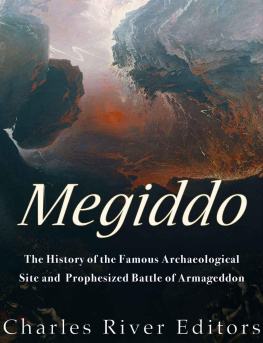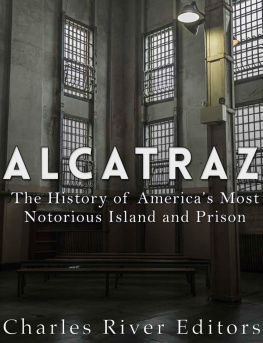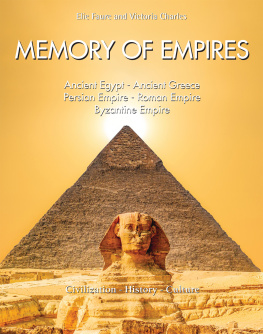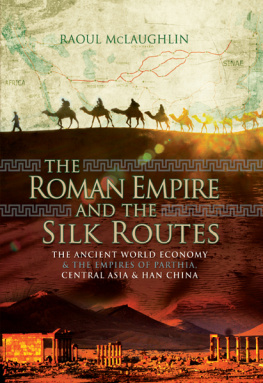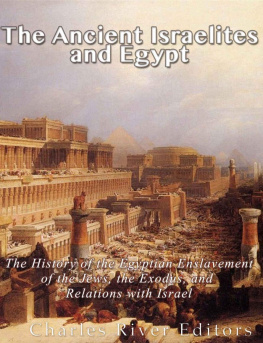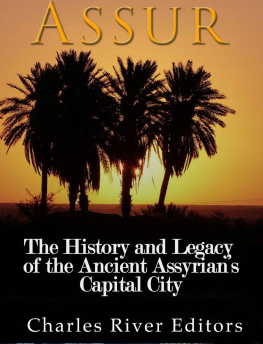Charles River Editors provides superior editing and original writing services across the digital publishing industry, with the expertise to create digital content for publishers across a vast range of subject matter. In addition to providing original digital content for third party publishers, we also republish civilizations greatest literary works, bringing them to new generations of readers via ebooks.
Sign up here to receive updates about free books as we publish them , and visit Our Kindle Author Page to browse todays free promotions and our most recently published Kindle titles.
Introduction

Hanays picture of some of the ruins of Tel Megiddo
Tel Megiddo
There are not many corners in the world that have seen as many people, civilizations, and armies as Tel Megiddo. Located in the western Jezreel Valley, it once laid upon the Via Maris , an ancient international trade route that connected ancient Egypt to the kingdoms and empires of Palestine, Syria, Anatolia, and Mesopotamia. It is because of this road that Megiddo saw so much carnage and bloodshed throughout its history. Many groups have coveted Tel Megiddo because of its strategic location guarding the entrance/exit of the Aruna Pass, now known as the Musmus Pass. Such groups ranged from the Canaanites, Egyptian, Israelites, Philistines and many others; including more recent states and empires, like the Ottomans, Napoleons French empire, and modern Israel. Megiddos occupational history, or ages of intensive human occupation, began during the Neolithic Age (c. late-fifth millennium B.C.E.) and ended in the Iron Age (c. late-seventh century B.C.E.). But, according to the New Testament, everyones stories will end with the coming of Armageddon , otherwise known as Tel Megiddo.
The history of the archaeological site and the Jezreel Valley is filled with many firsts and many lasts. Perhaps its wide plains were the location of the first recorded battle. It most certainly was the location of the first recorded chariot battle in history when the Pharaoh of Egypt, Thutmosis III of the Eighteenth Dynasty, attacked his former vassals, the Canaanites, after their kings formed a coalition with the Mesopotamian kings during the 15th century B.C.E. Such occurrences of violence and warfare have been common ordeals in the Jezreel Valley, and depending on who partook varied from guerilla-warfare to open-air fighting. The history in the Jezreel Valley had been so repetitively violent that the British General Edmund Allenby replicated, almost exactly, the tactic used by Thutmosis III nearly 3400 years before him when he too attacked Megiddo in 1918.
It is perhaps due to the many battles that the ancient scribes bestowed the image of Armageddon upon Megiddo. After all, the Hebrew words Har Megiddo , simply means the Mount of Megiddo. But despite the bloody history of the mound, and its valley, Megiddos location was eventually lost to history and only was rediscovered relatively recently.
Megiddo: The History of the Famous Archaeological Site and Prophesized Battle of Armageddon looks at the history of the site, its ruins, and its importance throughout the centuries. Along with pictures of important people, places, and events, you will learn about Megiddo like never before, in no time at all.
Tel Megiddos Chronological Sequence
Strata | Dates B.C.E. | Periods | Periods and Events |
XX | Neolithic/Chalcolithic | Remains on site |
XIX | c. 3300 3000 | Early Bronze Ib | Earliest Temple |
XVIII | Great Temple |
c. 3000 2700 | Early Bronze II | Gap in occupation? |
XVI | c. 2700 2500 | Early Bronze III | Round Altar |
XV | c. 2500 2000 | Early Bronze III-Intermediate Bronze | Three Megaron Temples |
XIV | Intermediate Bronze | Poor Settlement |
XIII X | c. 2000 1550 | Middle Bronze II | Renewed urban settlement; Lower Mound; massive fortifications |
IX VIIA | c. 1550 1130 | Late Bronze | Canaanite city state |
c. 1475 | Campaign of Thutmosis III |
VIII | th Century | El-Amarna period |
c. 1175 | Battle between Ramesses III and the Sea Peoples |
End of VIIA | c. 1130 | End of Late Bronze | Destruction of city and end of Egyptian hegemony |
VIB VIA | c. 1130 950 | Iron I | City in Canaanite tradition |
End of VIA | c. 950 | Destruction of Stratum VIA |
VB | c. 950 900 | Iron IIA | First Israelite settlement |
c. 925 | Campaign of Shishak |
VA IVB | c. 900 800 | Administrative city; palaces |
IVA | c. 800 732 | Iron IIB | Fortified city; stables |
| Assyrian conquest |
III | c. 732 650 | Assyrian district centre |
II I | c. 650 350 | Post-Assyrian and Persian settlement |
* Dates are not exact and may vary.
Geography
It is easiest to conceptualize the location of Megiddo sitting on the northern side of the Carmel Mountain acting like a gate of the Via Maris. Through this gate once moved inconceivable amounts of international trade and people from the Mediterranean Coast to the Jezreel Valley via the Aruna/Musmus Pass. The mountain range of the Carmel formed a formidable natural boundary, which stretches from near modern Haifa in the northwest to Mount Gilboa in the southeast. At this point another mountain range and the Wadi Arabah box in the southern Levant as they stretch south down the spine of Judah and onto the deserts of the Negev, Transjordan, and northern Arabia. As a result of such rough environmental conditions surrounding the Fertile Crescent and the once malaria infested marshes and sand dunes of the Mediterranean coast, the Via Maris meandered into western Palestine then turned east across Mount Carmel, thus avoiding the Haifa Peninsula.
In order to cross the mountain range there are three passageways. These passages issue into either the broad expanse of the Jezreel Valley, which then connects to the Beqa Valley, and Syria in the east, or the Plain of Akko, and connects with Phoenicia. The southernmost pass meanders through the Dothan Valley before emerging upon the Jezreel Valley, to the east of the ancient city of Tanaach. The northernmost pass winds around Megiddo and emerges near the ancient city of Yoqneam, to the west. While the Tanaach pass is the longest and least efficient passageway, it has the easiest entrance into the valley. The Yoqneam passageway on the other hand is considered the most physically arduous. In contrast to these two, the route through the slender Wadi Ara (Aruna/Musmus Pass) emerges upon the well-watered slopes of Megiddo after a relatively gentle incline.

